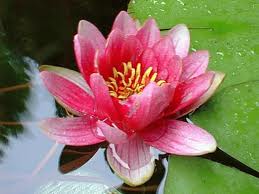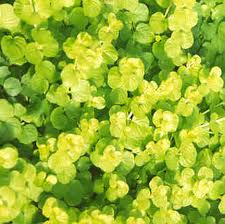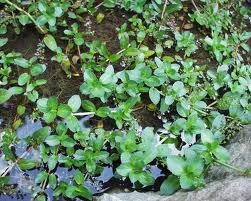





Traditional terracotta pots in varying shapes and sizes can be planted with aquatic plants and arranged to great effect on a paved terrace or patio, or alternatively on a pebble bed.
 Where you position the containers depends on the effect you seek, whether one of focus and contrast, or soft harmony. On a hard, reflective surface such as glazed tiles, the design and look of the pots are very important, but less so when the pots are partially hidden by other plantings.
Where you position the containers depends on the effect you seek, whether one of focus and contrast, or soft harmony. On a hard, reflective surface such as glazed tiles, the design and look of the pots are very important, but less so when the pots are partially hidden by other plantings.
Most terracotta pots are suitable for this kind of water feature. Because the volume of water they contain is relatively small, it will freeze quickly, and you will need to bring them indoors during the winter in colder areas. It is quite possible, therefore, to use some fine, fancy pots that are not frost resistant. In winter, drain off the water, but leave the plants growing in the pots and place them in a frost-free, but cool, place. They will come to no harm and can be started into growth again next spring.
For the best effect, in summer you should treat the pots as if they were miniature swamps. Fill the containers at least two-thirds full with aquatic compost, plant them up, top them off with fine gravel, and then add water. Plants should only rarely stand in more than 15 cm (6 in) of water. There is a potential problem with mosquitoes with this type of feature, since the water is deep enough for their larvae to survive and yet not deep enough to house fish to eat them. You can solve this problem by adding a drop of cooking oil to the water every couple of weeks; it creates a film over the water surface that is harmless to plants but prevents mosquito larvae coming up for air. In this feature, the appearance of the water surface is not important, since it is rarely visible as the pots become completely filled with plants.
 In your planting arrangments, avoid vigorous, tall plants, which may unbalance the container both visually and literally. Use creeping plants such as the golden-leafed Lysimachia nummularia ‘Aurea’ to provide tumbling foliage over the edge.
In your planting arrangments, avoid vigorous, tall plants, which may unbalance the container both visually and literally. Use creeping plants such as the golden-leafed Lysimachia nummularia ‘Aurea’ to provide tumbling foliage over the edge.
Other marginal plants that could be used in this feature include Butomus umbellatus, varieties of Iris laevigata, Pontederia cordata and Juncus effusus ‘Spiralis’, but use no more than two or three of the more upright types for each container if the plants are all to live happily together.
A delightful miniature water garden can be created in a window box. For the best effect, think carefully about its position and planting scheme.
A successful water feature can be created in a window box, but remember that the weight of saturated compost and water is considerable and that the window, box cannot be situated in the conventional position with the usual brackets. If you want it next to the window, it must be positioned on a solid window ledge.
While this water feature does not necessarily have standing water in it, the soil must be saturated, and so a watertight container is essential. There are many troughs and window box inserts to choose from. Generally troughs have no drainage holes and are perfect for the job; the inserts that fit into traditional window boxes mostly have drainage holes which will have to be blocked and made reliably watertight.
Bog garden plants are the best choice for this kind of situation. They can either be planted directly into the compost in the trough or box, or placed side by side in small planting containers. Plant-pot holders or covers serve this purpose well, since they have open sides and come in sizes that fit readily into a window box. Most proper aquatic planting baskets are too large. Although a solidly planted feature may look slightly more natural, plants growing side by side in pots are isolated from one another and are easier to control, since their roots will not grow together. They can also be easily lifted out for division or replacement.
Select fibrous-rooted plants rather than those that produce creeping underground stems or rhizomes; they are much better behaved and reduce the need for control to a mimimum. Mimulus and primulas are excellent for such features. Mimulus x hybridus ‘Calypso’ and M. x hybridus
‘Queen’s Prize’ provide summer-long colour and Sisyrinchium angustifolium gives a variation in stature and habit. Primula vialii produces startling lilac and red flowers in late spring before the mimulus start blooming. Although mimulus and primulas are perennials, in a window box they are best treated as annuals and replaced regularly, thereby ensuring a fresh, colourful and long-lasting display.
The opportunities for creating interesting small water features are enormous. A good-looking metal watering can could be used as the starting point for an attractive feature.
Any container that holds water can be used to make a water feature. One of the most common objects in the garden is the watering can, which, when planted up, can be a very attractive water garden feature.
By situating it on a paved or gravel base, as if it were simply standing out in the garden, but in a position where it is a focal point and surrounded by mixed planting, it will appear a natural part of the garden scene, just as planted wheelbarrows do. For the small garden or yard with limited space a single watering can is sufficient, but where there is a little more room, two cans of different shapes and sizes can be used together to complement one another.
It is possible to use a watering can as the outlet for a pump, the water filling the can and spraying from the spout. However, quite a powerful pump is required to lift the water sufficiently to make the water spray rather than dribble. It can be done, but it is more successful as a feature within a larger pool setting.
 A wide range of plants will adapt to the growing conditions in a watering can, which can be equated with those of the pool margin or bog garden, depending upon how much water is added. Visually, a long, low can works best with frothing, tumbling plants such as Veronica beccabunga (see image right) and Lysimachia nummularia ‘Aurea’ (see image above left) growing out of the top and spilling over. An upright can will take taller subjects better. Choose an elegant plant, such as the rushlike pink-flowered Butomus umbellatus, as a focal point.
A wide range of plants will adapt to the growing conditions in a watering can, which can be equated with those of the pool margin or bog garden, depending upon how much water is added. Visually, a long, low can works best with frothing, tumbling plants such as Veronica beccabunga (see image right) and Lysimachia nummularia ‘Aurea’ (see image above left) growing out of the top and spilling over. An upright can will take taller subjects better. Choose an elegant plant, such as the rushlike pink-flowered Butomus umbellatus, as a focal point.
Use aquatic compost as the growing medium and fill the watering can halfway. Do not plant anything in the can until the foliage is tall enough to come above the rim. The emerging plants will be weak if you plant them initially in the gloom of the watering can’s interior, and they will not grow well when they finally emerge.
Copyright © www.100flowers.win Botanic Garden All Rights Reserved